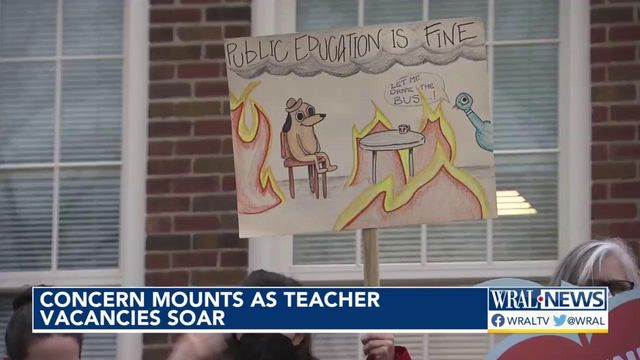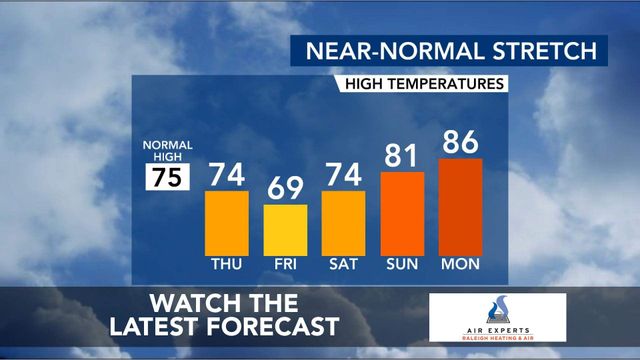NC needs 5,000 more teachers; vacancies up almost 60%
North Carolina’s public school systems saw a 58.4% increase in vacant teaching positions this fall, according to a new state report. Vacancies topped 5,000 teachers, comprising more than 5% of all teachers.
The report partly illustrates the challenges school leaders and teachers have voiced about fully staffing their schools — and adequately educating students with employees stretched thin. The growing struggle is now coinciding with pressure to speed up students’ learning and make up for the slowed pace of learning that occurred during the first year or more of the COVID-19 pandemic, resulting in lower student test scores.
At the same time, the state is reporting fewer students enrolled in the state’s 15 public colleges of education.
“If we don’t turn around this trend, we face serious consequences in our K-12 system,” said Eric Davis, chairman of the State Board of Education.
Tom Tomberlin, state Department of Public Instruction director of educator preparation, licensure and performance, warned schools that they will need to prepare for another drop in the number of teachers coming out of the state’s colleges.
The North Carolina State of the Teaching Profession report, issued by the state Department of Public Instruction, was presented Wednesday afternoon to the State Board of Education.
While the report shows high vacancies, it’s unclear just how many vacancies have been caused by teachers quitting or retiring and how many have been caused by classrooms being filled with a teacher who is just not certified in that subject area, often an emergency-licensed teacher. (The state counts positions filled by temporarily licensed teachers or long-term substitutes to be vacant.) The report cuts off attrition data in March 2022, rather than at the end of the school year, so it does not show how many teachers retired or quit when the school year ended. It does not show an increase in teacher attrition between March 2021 and March 2022.
WRAL News interviewed teachers last June who said they had quit that spring, after a statewide teacher survey from March showed about 7.2% of teachers and non-administrative educators (up from 4% in 2020) planned to leave the teaching profession entirely, nearly 7,800 people.
The new State of the Teaching Profession report, shows 5,091 teaching positions were vacant on the 40th day of school this fall, compared to 3,214 vacancies on the 40th day in 2021 and between about 1,500 and 1,700 vacancies on the 40th day of 2018, 2019 and 2020 — the first three years the data were recorded.
Tomberlin said 3,660 of the vacancies this year are teachers with emergency licenses. It’s unclear what that figure was in past years.
Anecdotally, education leaders say they are hiring more temporarily licensed teachers to fill positions, as enrollment and graduation from the state’s education colleges has been dropping for several years.
But some other data show both vacancies and temporarily licensed teachers are on the rise.
A report from the North Carolina School Superintendents Association last August showed an increase in both vacancies and the use of non-certified teachers. While the state considers a position vacant if it’s filled by an emergency-licensed teacher, retired teacher or long-term substitute, the Superintendents Association did not in its survey.
The group reported 3,619 vacancies across 98 of 115 school systems surveyed in August 2022. It reported 2,355 vacancies in 98 of 115 surveyed school systems in August 2021. The group those district hired 3,618 emergency-licensed teachers in 2022, compared to 1,942 in 2021.
Wednesday’s state report breaks down vacancies by district in fall 2021 but not for fall 2022, which is what the overall vacancy number refers to.
‘A problem for the future’
North Carolina is losing its early career teachers.
The State of the Teaching Profession report showed 1,720 “beginning teachers” (in their first five years) quit between March 2021 and March 2022, or about 13.1%, the highest percentage since March 2016, when 14.7% of beginning teachers — 2,252 beginning teachers — quit.
“That poses a problem for the future,” Tomberlin said.
Superintendent Catherine Truitt said said the state needs to do a better job supporting beginning teachers.
“They don’t get enough time in the classroom while they are in their [education preparation program] to just fly by the seat of their pants when they are in their own classroom,” Truitt said. “They need to have targeted, better supports and it needs to come from within their building.”
Enrollment in North Carolina’s public colleges of education has been less than reliable in the past decade.
Just 4,941 new students enrolled in them last fall, down from 6,820 in 2014. It reflects a decade-long overall decline in enrollment in those schools, though enrollment briefly spiked during the first two years of the COVID-19 pandemic.
Board Vice Chairman Alan Duncan suggested teaching has become a less attractive profession over the years.
“I think it’s fair to say that we could be seeing that taking on a greater force,” Duncan said.
Davis and Duncan urged making teacher feel more professionally respected, namely by increasing their pay.
According to the U.S. Census Bureau, teachers earn significantly less than similarly educated peers. North Carolina traditional public school teachers are required to have Bachelor’s degrees.
'There are some parts that makes folks walk away'
Turquoise Parker, a teacher at Durham Elementary School, looks forward to seeing her students.
"This is my 12th year teaching," said Parker. "The amazing children who I call 'Mrs. Parker's Professors,' they bring me back every single day.
The increased vacancies, caused by increased workloads, calles for better pay and challenges brought on by the COVID-19 pandemic, have contributed to the spike in teaching vacancies.
"There are lots of beautiful parts of being in education," Parker said. "But there area some parts that makes folks walk away."
North Carolina Association of Educators President Tamika Walker Kelly said the report confirms what advocates have been sounding the alarm on for months.
"It is detrimental to the growth and economic development of our state as a whole," Kelly said. "We fear that one day a student will walk into a classroom and there won't be a high quality teacher there to instruct them on their academic journey."
Increased pay came up often from educators as a way to retain them. State Superintendent Catherine Truitt wants the state to do a better job supporting these educators.
Teachers who are still passionate about their students, like Parker, said they want to feel professionally respected.
"Listening to rank-and-file folks who are in positions of power, you don't know," Parker said. "You can't know what to do to transform our schools unless you listen to people."











